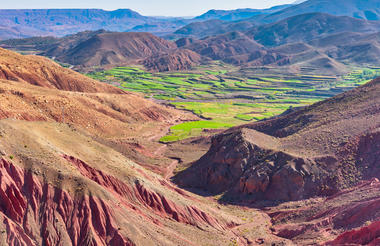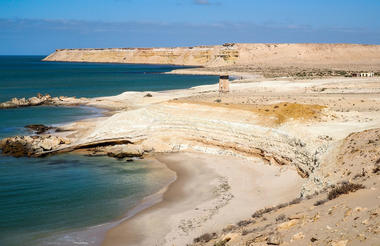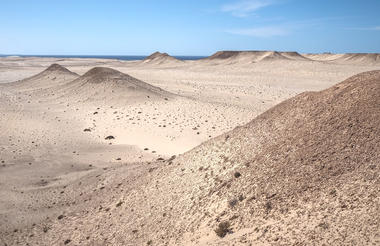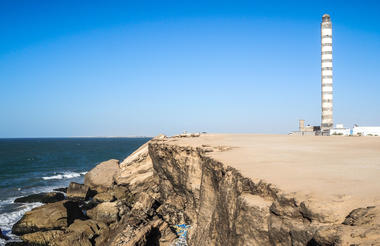An exotic fusion of Southern Mediterranean, Arabic and African influences, Morocco is an enticing combination of ancient cities and Roman ruins, sweeping deserts and centuries-old medinas, mosques and minarets, winding alleyways and vibrant markets, gorgeous beaches and rugged mountains. The Imperial Cities of Fes, Marrakech, Meknes and Rabat have all had a stint as the national capital and are liberally studded with attractions, including a plethora of ancient architecture, museums and souks (markets). The coastal city of Casablanca boasts one of the largest mosques in the world, while Tangier, on the Mediterranean coast, features some beautiful bays and sandy coves. Visitors can look forward to sampling exotic Berber cuisine, sipping on a fresh cup of coffee or a mint tea at a streetside cafe, hike Toubkal - North Africa’s highest peak or enjoy camel trekking in the desert.
Situated between the two cities of Casablanca and Marrakesh, the resort town of Oualidia wraps around a spectacular seawater lagoon fringing the Moroccan coastline. Oualidia is an excellent spot for surfers to catch some waves and offers visitors a wide range of other water activities including windsurfing, canoeing, kayaking, and fishing trips. Visitors can spend a relaxing day on the spectacular sun-drenched beach, spot a variety of migratory birds resting and feeding in the glittering lagoon such as flamingo, storks, egrets, and warblers; and during the months from August to October, whales can be seen frolicking off the coast.



Taking up most of Africa’s north-western corner, the Atlas Mountains extend for roughly 2400 kilometres across Morocco, Algeria and Tunisia, reaching to over 4000 kilometres above sea level at their zenith, Toubkal Mountain. The Atlas range is exceptionally scenic and known for the many rare and endangered plants and animals occurring there, some of which are found nowhere else on earth. Visitors can explore some of North Africa’s most remote villages tucked away in the deep valleys of the rugged range, hike and bike through the spectacular scenery or visit the impressive kasbahs of Ouarzazate, Tifoultoute, Telouet and the magnificent Ait Ben Haddou, one of Morocco's most photogenic buildings.



Situated to the north of the foothills of the snow-capped Atlas Mountains and fringing the famed Sahara, the bustling UNESCO-listed city of Marrakesh is an enchanting travel destination. Marrakesh is also home to the largest traditional Berber market in Morocco and one of the busiest squares in the world, known as Djemaa el Fna. Don’t miss the opportunity to visit this square in the evening as it transforms into an enormous, open-air restaurant, and browse through exquisite carpets, spices and a myriad of other items. Art, design and architecture enthusiasts flock to the city to see its incredible artisan achievements, so beautifully expressed at the glorious Bahia Palace, Dar Si Said and Saadian Tombs, as well as at several museums. The other-worldly Jardin Majorelle is also unmissable.



At the intersection of the Dades and Draa Valley lies the relaxed Moroccan town of Ouarzazate. Surrounded by some unbelievably picturesque terrain, the town is characterised by the red-glowing kasbah at Ait Ben Haddou, the snowcapped High Atlas Mountains, and the spectacular Sahara Desert with its rolling dunes, vast canyons and deep gorges. These exotic backdrops have served as the location for a slew of Hollywood movies which have turned this once sleepy town into Morocco’s version of Hollywood. The town is a popular stopover point for tourists on their way to the Sahara. Its palm-fringed boulevards are lined with grand palaces, bustling souks, old adobe buildings and film studios. It's an ideal location for hanging out at one of the many charming cafés, sampling some delicious local Moroccan cuisine and perhaps even spotting one of the many celebrities who frequent this fascinating North African city.



Carved by the Dadès River in Morocco's High Atlas Mountains, the Dadès Gorges are deep canyons with steep walls lined with cedar trees and verdant vegetation. Springs feed groves of palm and almond trees, while irrigation sustains fields of wheat, fig, almond, and olive orchards. Located in Ouarzazate and Errachidia provinces, the highest point is 3 000 metres above sea level, narrowing to just two metres wide. A haven for hikers, climbers, and adventurers, the area offers opportunities for trekking and rock climbing, with caves for spelunking. Encounter breathtaking rock formations showcasing hues from tan to rust red, accessible via the Road of a Thousand Kasbahs. Historic kasbahs and Berber villages overlook the valley, some converted into boutique hotels. The area teems with wildlife like ibexes, Barbary macaques, and birds of prey.



One of Africa’s driest and lowest-lying countries, Western Sahara is located in North West Africa, bordering the North Atlantic Sea. The nation is a disputed territory, with both Morocco and pro-independence groups laying claim to its desert landscapes - and more specifically its rich natural reserves. Politics aside, Western Sahara has some spectacular tourist attractions. The glittering jewel in its crown is Dakhla, a picture-perfect coastal city that offers superb kite-surfing, windsurfing and fishing. On either side of Dakhla, idyllic beaches stretch for miles along the oceanfront, while inland lies the stony desert and blush-coloured Saharan sand dunes. Culturally, the country is an intricate and beguiling mix of Berber, Arab and African culture, and the rare travellers that do visit can look forward to warm hospitality - a trademark quality of the local people.
One of Africa’s driest and lowest-lying countries, Western Sahara is located in North West Africa, bordering the North Atlantic Sea. The nation is a disputed territory, with both Morocco and pro-independence groups laying claim to its desert landscapes - and more specifically its rich natural reserves. Politics aside, Western Sahara has some spectacular tourist attractions. The glittering jewel in its crown is Dakhla, a picture-perfect coastal city that offers superb kite-surfing, windsurfing and fishing. On either side of Dakhla, idyllic beaches stretch for miles along the oceanfront, while inland lies the stony desert and blush-coloured Saharan sand dunes. Culturally, the country is an intricate and beguiling mix of Berber, Arab and African culture, and the rare travellers that do visit can look forward to warm hospitality - a trademark quality of the local people.



An exotic fusion of Southern Mediterranean, Arabic and African influences, Morocco is an enticing combination of ancient cities and Roman ruins, sweeping deserts and centuries-old medinas, mosques and minarets, winding alleyways and vibrant markets, gorgeous beaches and rugged mountains. The Imperial Cities of Fes, Marrakech, Meknes and Rabat have all had a stint as the national capital and are liberally studded with attractions, including a plethora of ancient architecture, museums and souks (markets). The coastal city of Casablanca boasts one of the largest mosques in the world, while Tangier, on the Mediterranean coast, features some beautiful bays and sandy coves. Visitors can look forward to sampling exotic Berber cuisine, sipping on a fresh cup of coffee or a mint tea at a streetside cafe, hike Toubkal - North Africa’s highest peak or enjoy camel trekking in the desert.
Situated in the vast desert region of Saharan Morocco, dividing Morocco and Algeria, Erg Chebbi is one of two Moroccan ‘ergs’, which are a sea of dunes. What it lacks in size - compared to the deserts of Algeria, Libya and Namibia - it makes up for in its extraordinarily scenic golden landscape, which changes colours dramatically at sunset. The dunes of Erg Chebbi span over 30 kilometres and rise up to 160 metres. From Merzouga, the tourist centre, take a camel trip into the wild; enjoy quad biking; or stay overnight in a desert oasis called a Moroccan bivouac.



Morocco’s second-largest city and the country’s former capital, Fes (Fez) is an exotic mix of Arabic architecture, ancient alleyways calls to prayer and colourful markets; all mixed in with a good dose of modern culture. Home to the venerated Karaouine Mosque, which dates back to 859 AD and incorporates an Islamic university, and to the country’s most hallowed shrine, the Zaouia Moulay Idriss II; Fes is regarded as the spiritual seat of Morocco. Music lovers should try to synchronise their trips with the annual Festival of Sacred Music, one of the highlights of the city’s cultural calendar showcasing diverse performances of spiritual and religious music; while those with a penchant for shopping can browse the mesmerizing colourful markets selling an exquisite array of silver, leather and other handicrafts up for grabs.



Casablanca lies on the Atlantic coast, in central-western Morocco. Fondly known by locals simply as ‘Casa', the capital is the industrial, economic and cultural heart of this remarkable country, as well as its most cosmopolitan, liberal, and progressive city. While most visitors overlook Casablanca in favour of Morocco’s more popular and exotic tourist areas, this sprawling metropolis has plenty to offer the discerning traveller and has many hidden historical and cultural gems just waiting to be discovered. The city is famous for its spectacular Art Deco and Moorish Revival architecture, constructed during the Colonial Period. Explore the Old Medina, a tiny, ancient, walled village; visit the impressive King Hassan II Mosque; discover the ornate rooms, masterfully tiled floors, and intricately carved wooden ceilings of the Hispanic-Moorish Mahkama du Pacha; or simply watch the world go by at one of the many ocean-view cafes along the waterfront boulevard.








